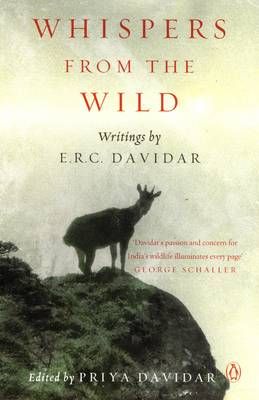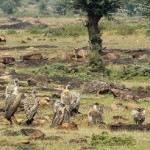Whispers from the Wild
writings by E.R.C. Davidar
The name of E.R.C. Davidar is familiar with people who have read his reports in the BNHS journals. He had earlier written a beautiful book titled Cheetal Walk describing his tales from Nilgiris. Unfortunately it had gone out of print. Fortunately, his daughter Priya Davidar decided to bring out an edited version of E.R.C. Davidars writings and this anthology is titled Whispers from the Wild.
This is not just a biography of an avid naturalist, or tales of adventure of an early settler in the blue mountains, when it still was wild enough. This book also documents the ecological changes in the Nilgiri hills, the socio-economic changes due to dam building and other modernisation activities on its people and the consequent impact on wildlife. That is an invaluable record, if we care to learn from history.
Like many other early settlers he too was a shikari. However, he was a man of conscience and unlike many others never took to commercial shikar. He could have easily made money by killing tuskers entering his fields and legally selling the tusks or legally bring in hunting parties to make money, especially in dollars which was in short supply those days.
Instead of hunting and making money, he went ahead to make his place a haven for animals. It was interesting to hear about his efforts to discourage local shikaris from bringing hunters close to his jungle abode. At Cheetal Walk, we not only provided them a safe haven but took whatever steps possible through the NWEA and other fora to protect them. We dug pools in the stream bed during summer for thirsty elephants. We also put out salt and established salt licks which became popular with elephants. The elephants repaid us in their own way by giving us the pleasure of their company and acting as watchmen. (Page 131) He later became the president of the Nilgiri Game Association the predecessor of the Nilgiri Wildlife and Environment Association (NWEA).
The author also writes about his views on various wildlife species based on his encounters or surveys which he did in his later years. His views on species like wild boar, which are detested for crop depredations leading to clamor for official cull orders helps understand how dangerous these killings can be on the species. Wild boar populations are not stable. They seem to suffer from widely fluctuating numbers. There are years of boar drought followed by years of plenty when you see a pig in every bush. Disease could be the reason for this rise and fall. An animal that is subject to fluctuating fortunes in its status, deserves careful management, particularly since it is one of the principal prey species of the large carnivores. Page 155
Folks often believe and call animals blood-thirsty, which he rightly refutes by saying uncalled-for aggression and bloodshed are considered to be the hallmark of the jungle. Nothing can be farther from the truth. In the jungle intra-specific as well as inter-specific aggression are, as far as possible, avoided through well-regulated postures and gestures. Side presentation is one such. A would-be aggression is put off on seeing the larger outline of its opponent. Some animals hunch, some bristle, to exaggerate their outlines. However, despite his well learned jungle lore, he made a mistake by ignoring a gaur bull and trying to move fast in the direction of the jungle sounds, probably of fighting animals, and was gored by the bull gaur. He was fortunate to survive the massive assault and could recover, albeit with a damage to his spine. That account should be read by todays jeep riding photographers, researchers and conservationists who call themselves experts.
His experiments in creating a contraption to imitate the call of the tiger is very interesting and speaks of a inquisitive mind and he being a keen student of jungle lore. He mentions that he envied Jim Corbetts ability to call tigers at will, through sheer vocal effort. Instead of burning in envy due to his limitations, he kept looking for solutions. He spotted a little tribal boy in a village fair using a small contraption made by a peacock feather attached to an earthen pot covered with goat hide on one end and an opening at the other to imitate the tigers call and then quickly created a similar contraption to successful test it on a wild tiger. His book is filled of many such interesting tales which not only throws light on this remarkable man but also on a bygone era.
This book Whispers from the Wild published by Penguin Books has 345 pages and is priced at Rs. 399/-. I think this is a very good book not only for naturalists, researchers, preservationists and wildlife enthusiasts but also will make an ideal gift to youngsters to help stimulate the love for the wild.
- GoPro Hero 12 Black - 6 September,2023
- Leopards: The Last Stand - 2 July,2023
- Drifting in the Waters of Sundarbans - 26 March,2023












This is an excellent book particularly for us who once inducted to nature in young age is addicted to it. In past inside the forest a NGO arranged an artificial increase of preys for a wild cats, wolves and Hyenas and small drains for circulation of water. Five years later, these wild animals became lean and thin, unable to run quickly and became easy prey for Leopards. A wild life warden told us that plenty easy prey made them lazy and drop of digestive power.